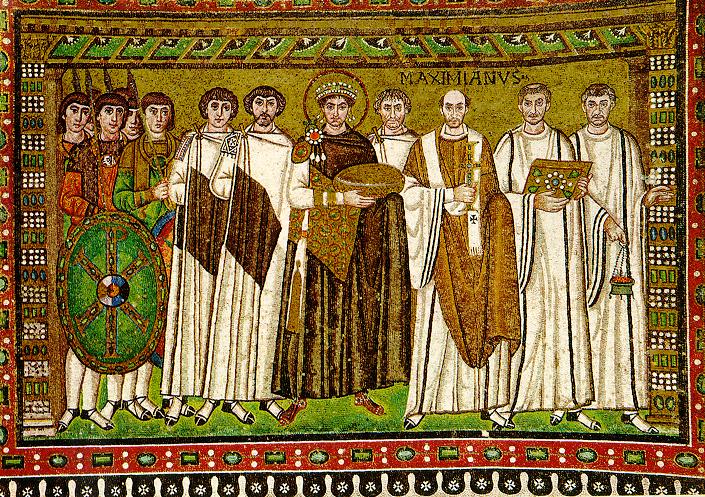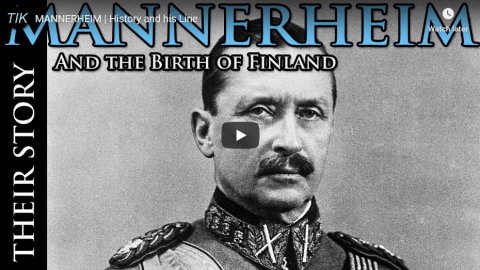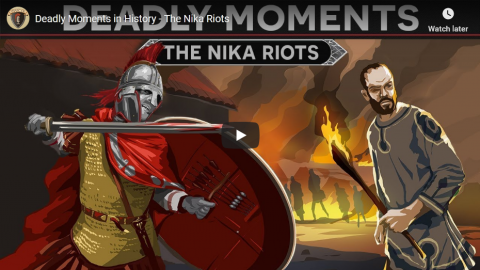TIK
Published 22 Jun 2017Carl Gustav Emil Mannerheim towers over all other characters of the Winter War, and of Finnish history in general. This video is a brief introduction to one of the great leaders of the 20th Century (and according to a TV poll in 2004, the greatest Finn of all time). Full script is available as captions/subtitles, and the source I used for this video is –
Trotter, W. The Winter War: The Russo-Finnish War of 1939-40. Aurum Press Ltd, 2003.
If you’d like to help me make these videos, consider supporting me on Patreon https://www.patreon.com/TIKhistory
January 13, 2020
MANNERHEIM | History and his Line
The Nika riots in Constantinople (with bonus NASCAR analogies)
Not only does Tamara Keel provide interesting and informative gun information, she also has at least a vague interest in late Classical/early Medieval history:

Court of Emperor Justinian with (right) archbishop Maximian and (left) court officials and Praetorian Guards; Basilica of San Vitale in Ravenna, Italy. The bearded man to Justinian’s right is believed to be Belisarius. (via Wikimedia)
The center of social life in Constantinople was the Hippodrome, a massive stadium where chariot races were held. Chariot racing was wildly popular with all strata of society, and everybody was a fan of one team or another; the Blues, the Greens, the Whites, and the Reds. Although as time went on, hardly anybody paid attention to anybody other than the Blues and the Greens. Kinda like Dale Jr. fans and Jeff Gordon fans and who cares about Kurt Busch anymore ’cause he’s a tool.
So, everybody who was anybody was a fan of the Blues or the Greens. You only hung out with fellow Dale fans, all the Jeff Gordon fans voted the same way, you beat the crap out of rival fans in bar fights when you could. Trouble really erupted, however, when some popular ringleaders from each faction were imprisoned on murder raps after a bit of friendly head-busting got out of hand after a contested race.
Dale fans and Jeff Gordon fans united and went wild in the streets, burning and looting and actually laying siege to the palace in a mob scene. The emperor Justinian (via someone expendable, no doubt) announced his willingness to accede to their demands, even to the point of agreeing to abdicate in favor of their choice for a new ruler. Fortunately for Justinian, his wife Theodora and a senior eunuch in the palace bureaucracy named Narses had the stones the emperor lacked. They put their heads together with Belisarius and Mundus, two great Byzantine generals, and hatched a plan.
As the tens of thousands of rioters thronged in the vast Hippodrome, waiting for the new emperor’s coronation, Belisarius and his bodyguard of no more than a couple hundred steppe archers took the passageway under the street from the palace to the imperial box in the stadium. With the crowd focused on the impending ceremony, nobody noticed the archers fanning out in the skybox until they started volleying into the crowd. Panic ensued and, leaving a litter of 24 flags and 88 mesh-back ball caps and shot-up, trampled bodies, the crowd stampeded for the big main gates off the racetrack.
Unfortunately, Mundus and his bodyguard were drawn up in ranks blocking the exit, and they opened fire into the front rows of the fleeing mob. Needless to say, when all was said and done, the backbone of the rioters was broken. Thousands had been shot, and many thousands more were crushed in the press. Justinian held onto his crown, no thanks to his own dithering.
Deadly Moments in History – The Nika Riots
Invicta
Published 27 Feb 2018We relive the deadly Nika Riots which brought the Emperor Justinian to his knees and resulted in the death of 30,000 civilians. In our journey we will explore the history of chariot racing, the undercurrents of dissent, and the blow by blow unfolding of the riot.
Support future documentaries: https://www.patreon.com/InvictaHistory
Twitter: https://twitter.com/InvictaHistoryDocumentary Credits:
Research: Invicta and Luas McCahill
Script: Invicta
Artwork: Robbie McSweeney
Editing: Invicta
Music: Total War Soundtrack, Dreamnote, RecognitionLiterary Sources
–History of the Wars, I by Procopius
–Empress Theodora by J. A. S. Evans
–Justinian: The Last Roman Emperor by G. P. Baker
QotD: Early civilizations and the barbarians
The book [Against The Grain] ends with a chapter on “barbarians”. Scott reminds us that until about 1600, the majority of human population lived outside state control; histories that focus on states and forget barbarians are forgetting about most humans alive. In keeping with his thesis, Scott reviews some ancient sources that talk about barbarians in the context of people who did not farm or eat grain. Also in keeping with his thesis, he warns against thinking of barbarians as somehow worse or more primitive. Many barbarians were former state citizens who had escaped state control to a freer and happier lifestyle. Barbarian tribes could control vast trading empires, form complex confederations, and enter in various symbiotic relationships with the states around them. Scott wants us to think of these not as primitive people vs. advanced people, but as two different interacting lifestyles, of which the barbarian one was superior for most people up until a few centuries ago.
Scott Alexander, “Book Review: Against The Grain“, Slate Star Codex, 2019-10-15.





